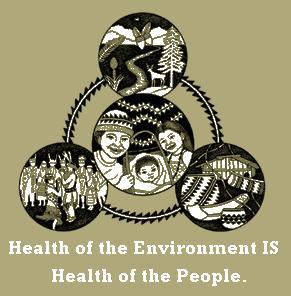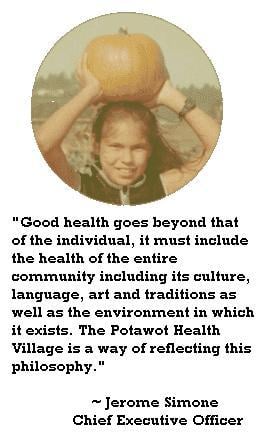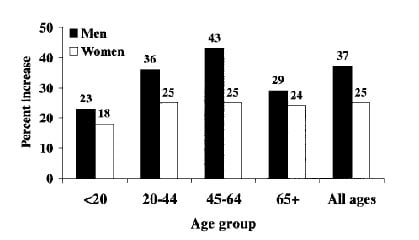Anonymous1 (talk | contribs) No edit summary |
m (Converting raw Appropedia links to piped wikilinks) |
||
| Line 11: | Line 11: | ||
===<u><big>Potawot</big></u>=== | ===<u><big>Potawot</big></u>=== | ||
The Diabetes program available at Potawot covers nine tribes and more than 13,000 American Indians, consisting mainly of Yurok, Weeot and Tolowa Tribal members. Potawot hosts United Indian Health Services' (UIHS) nationally recognized tobacco awareness and diabetes prevention programs which are featured at the Health Village. <ref name="Potawot">http://pages.prodigy.net/richardspini/_wsn/page5.html Potawot Info Services Last Accessed: 10/28/08</ref> Because diabetes has become such a severe problem in the community, and throughout the world, Potawot and the UIHS have begun to take steps to address the problem (Fig. 2). The Potawot diabetes outreach program allows its participants to join groups that go on walks (Fig. 3 through 5) Monday through Wednesday during clinic hours. <ref name="Piefer">Interview of Barbara Piefer from Potawot 10/28/08 (707) 825-4180 (Interviewed by [ | The Diabetes program available at Potawot covers nine tribes and more than 13,000 American Indians, consisting mainly of Yurok, Weeot and Tolowa Tribal members. Potawot hosts United Indian Health Services' (UIHS) nationally recognized tobacco awareness and diabetes prevention programs which are featured at the Health Village. <ref name="Potawot">http://pages.prodigy.net/richardspini/_wsn/page5.html Potawot Info Services Last Accessed: 10/28/08</ref> Because diabetes has become such a severe problem in the community, and throughout the world, Potawot and the UIHS have begun to take steps to address the problem (Fig. 2). The Potawot diabetes outreach program allows its participants to join groups that go on walks (Fig. 3 through 5) Monday through Wednesday during clinic hours. <ref name="Piefer">Interview of Barbara Piefer from Potawot 10/28/08 (707) 825-4180 (Interviewed by [[User:Crazapes7|Juliene Sinclair]]and [[User:Yuvizela|Yuvizela Martinez]]) </ref> Members of Potawot also have the opportunity to join nutritional garden (Fig. 6 through 8) activities. The community food garden at Potawot consists of a two acre organic garden which produces 6-10 tons of fresh produce per year. It is distributed to the Indian community through produce stands, baskets, and other gardening outreach programs.<ref name="UIHS">http://www.uihs.org/ns/services.html UIHS Last Accessed: 10/28/08</ref> | ||
| Line 80: | Line 80: | ||
*The [http://diabetes.niddk.nih.gov/dm/pubs/eating_ez/index.htm Eating Healthy] website provides the reader with directions for eating healthy and staying healthy. | *The [http://diabetes.niddk.nih.gov/dm/pubs/eating_ez/index.htm Eating Healthy] website provides the reader with directions for eating healthy and staying healthy. | ||
*The [http://ndep.nih.gov/diabetes/pubs/FS_AmIndian.pdf ''Diabetes Epidemic Among American Indians''] article provides insight on the epidemic that is spreading throughout the American Indian community. | *The [http://ndep.nih.gov/diabetes/pubs/FS_AmIndian.pdf ''Diabetes Epidemic Among American Indians''] article provides insight on the epidemic that is spreading throughout the American Indian community. | ||
*Check out the [ | *Check out the [[:Category:Potawot|Potawot Category]] to learn more about other Potawot topics. | ||
=== References === | === References === | ||
<references/> | <references/> | ||
The Potawot Diabetes Outreach Program page was edited and created by Engr. 115 student [ | The Potawot Diabetes Outreach Program page was edited and created by Engr. 115 student [[User:Yuvizela|Yuvizela Martinez]]. | ||
[[Category:Engr115 Intro to Engineering]] | [[Category:Engr115 Intro to Engineering]] | ||
[[Category:Potawot]] | [[Category:Potawot]] | ||
Revision as of 03:24, 6 July 2010


Potawot
The Diabetes program available at Potawot covers nine tribes and more than 13,000 American Indians, consisting mainly of Yurok, Weeot and Tolowa Tribal members. Potawot hosts United Indian Health Services' (UIHS) nationally recognized tobacco awareness and diabetes prevention programs which are featured at the Health Village. [3] Because diabetes has become such a severe problem in the community, and throughout the world, Potawot and the UIHS have begun to take steps to address the problem (Fig. 2). The Potawot diabetes outreach program allows its participants to join groups that go on walks (Fig. 3 through 5) Monday through Wednesday during clinic hours. [4] Members of Potawot also have the opportunity to join nutritional garden (Fig. 6 through 8) activities. The community food garden at Potawot consists of a two acre organic garden which produces 6-10 tons of fresh produce per year. It is distributed to the Indian community through produce stands, baskets, and other gardening outreach programs.[5]
What is Diabetes?
There are many reasons why Potawot and UIHS try to help educate as many individuals as they can. One of the main reasons is because of the how diabetes affects an individual. Diabetes is a disease that affects the way an individual’s body uses food for energy. Normally, the sugar an individual takes in is digested and broken down to a simple sugar, known as glucose. Insulin, a hormone produced by the pancreas, helps move the glucose into cells. A healthy pancreas adjusts the amount of insulin based on the level of glucose. However, if an individual has diabetes, the process breaks down, and blood sugar levels become too high. People with Type 1 diabetes are completely unable to produce insulin, and people with Type 2 diabetes can produce insulin, but their cells don't respond to it. [6] Due to the problems that diabetes causes, Diabetic patients at Potawot have their eating habits monitored as closely as possible. Clients of the Diabetic program are also encouraged to participate in more rigorous exercise routines.
Programs
Diabetic Native Americans and family members, who are UIHS members or enrolled at the Potawot health clinic, have a wide variety of activities and information available to them. Diabetics are provided with many different opportunities to enhance their health beyond dietary improvements. Their choices range from exercise and group sessions to one-on-one counseling.
The Potawot diabetes outreach program also provides members with a monthly luncheon, entitled Repchem. The Repchem luncheon is for members who are at risk or already have diabetes, along with their family members. The Repchem luncheon is held on every second Wednesday from 11 am to 1 pm at Potawot. The Repchem luncheons consists of a presentation on healthy lifestyle choices followed by a nutritious lunch.[5] The nutritious lunch includes native foods such as fish, fruits, and fresh vegitables.[4]
Services:[7]
Information and Services Provided by the Potawot Health Clinic Include:
- Individual and Group Fitness/Movement Programs.
- Diabetes Counseling.
- Foot Care Information.
- Diabetes Education by Certified Diabetes Educators (CDEs).
- Instructions and review of blood glucose monitoring.
- Interpretation of blood tests and medication use.
- What you need to stay healthy and happy.
- Support Groups.
- Monthly Luncheons.
- Group Education Classes.
- Home Visits.
- Diabetes Education and Support.
- Community Health Events.
Future Plans
The Potawot Health Clinic is also planning on constructing some small work out stations along the paths (Fig. 4 and 5). The work out equipment will include Pull up bars.
- Pictures of Potawot Paths and the Garden
-
Fig. 3: One of the paths at Potawot.
-
Fig. 4: A rest area on one of the paths.
-
Fig. 5: Another rest stop.
-
Fig. 6: The entrance to the Garden.
-
Fig. 7: The garden.
-
Fig. 8: Some vegetables
Diabetes and Native Americans: The Facts
- The risk of a leg amputation is 15 to 40 times greater for a person with diabetes. [8]
- Someone is more likely to develop type 2 diabetes if: [10]
- They are overweight.
- They are 45 years old or older (Fig. 9).
- They have a parent, brother, or sister with diabetes.
- Their family background is African American, American Indian, Asian American, Hispanic American/Latino, or Pacific Islander.
- They have had gestational diabetes or gave birth to at least one child that weighed more than 9 pounds.
- Their blood pressure is 140/90 or higher.
- Their HDL cholesterol is 35 or lower, or their triglyceride level is 250 or higher.
- They are fairly inactive, or they exercise fewer than three times a week.
Funding
Funding for diabetic programs provided at Potawot such as the Diabetes Expansion Project are funded by the California Endowment. The project works to assist California Indian Health Clinics in Diabetes Program Development & Education in regards to diabetes, complications of diabetes and diabetes prevention.[7]
Related Links
- The Native Americans and Diabetes website provides links to sites that explain the severity of diabetes in the Native American community.
- The Eating Healthy website provides the reader with directions for eating healthy and staying healthy.
- The Diabetes Epidemic Among American Indians article provides insight on the epidemic that is spreading throughout the American Indian community.
- Check out the Potawot Category to learn more about other Potawot topics.
References
- ↑ 1.0 1.1 http://www.uihs.org/kuwahdahwilth.html Potawot Images provided by UHIS Accessed: 10/26/08
- ↑ 2.0 2.1 Pictures Edited By User: Yuvizela Martinez on 10/27/08
- ↑ http://pages.prodigy.net/richardspini/_wsn/page5.html Potawot Info Services Last Accessed: 10/28/08
- ↑ 4.0 4.1 Interview of Barbara Piefer from Potawot 10/28/08 (707) 825-4180 (Interviewed by Juliene Sinclairand Yuvizela Martinez)
- ↑ 5.0 5.1 http://www.uihs.org/ns/services.html UIHS Last Accessed: 10/28/08
- ↑ http://diabetes.about.com/od/whatisdiabetes/p/whatisdiabetes.htm About.com Accessed: 10/28/08
- ↑ 7.0 7.1 http://www.uihs.org/chw/services.html#a UIHS Services Last Accessed: 10/28/08
- ↑ 8.0 8.1 http://vltakaliseji.tripod.com/Vtlakaliseji/id2.html Vtla Kaliseji Last Accessed: 10/28/08
- ↑ Prevalence of Diabetes Among Native Americans and Alaska Natives, 1990–1997, December 2000
- ↑ http://diabetes.niddk.nih.gov/dm/pubs/preventionprogram/index.htm NDIC Last Accessed: 10/28/08
The Potawot Diabetes Outreach Program page was edited and created by Engr. 115 student Yuvizela Martinez.






